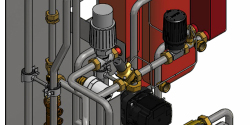

Manufacturers of flow control systems and pressure independence control valves, Frese, believes new housing developments should be connected to community hot water systems if the UK hopes to meet stringent European carbon emission targets.
The company thinks the district and community systems, which cut domestic carbon emissions in Denmark by a quarter between 1980 and 2010, would have a similar effect here in the UK.
Mr Hart, managing director of Frese, said: “Community heating systems are proven to make a huge difference to energy consumption. An apartment building, a street or even a district is served by one main boiler which improves system efficiency and facilitates the use of zero or low-carbon heat sources such as biomass boilers, CHP engines and heat pumps.
“This sends hot water through a primary flow system to every connected dwelling. Using a Heat Interface Unit (HIU), domestic water in a secondary system is heated by the hot pipes of the primary system. This allows individual households to retain control of heating and hot water temperature and even be metered separately to monitor use while reducing energy waste.”
In addition to supplying its pressure independent flow and temperature control valves to others, Frese is now producing its own HIU, the Frese CONHEAT unit. Each unit is built to fit each new flow system but all feature its industry-leading ALPHA constant flow regulators, and PV Compact differential pressure control valves. This creates a super-efficient system ideal for multiple-dwelling developments.
Mr Hart continued: “We firmly believe that this is the future for developers. Once there was industry scepticism about the system efficiency benefits of the dynamic balancing valves we produced, now they are the industry standard.
“Frese is always looking at how we can move forward and meet the challenges of consumer demands and energy efficiency, and we are confident that this will change the game for developers and help them make a major contribution to the reduction of the nation’s carbon emissions.”
If you'd like to keep up-to-date with the latest developments in the heating and plumbing industry, why not subscribe to our weekly newsletters? Just click the button below and you can ensure all the latest industry news and new product information lands in your inbox every week.